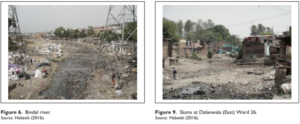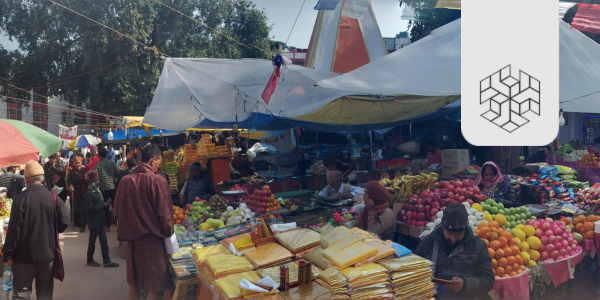by – Simran Kapoor
Introduction: Unveiling the Predicament
Dehradun, a serene Himalayan city nestled in Shivalik Hills, is dealing with a growing problem—more and more seasonal slums are popping up along its disappearing riverbanks. Doon is the Valley of five Ganga and Yamuna tributaries—Rispana, Bindal, Asan, Song and Tons. They are proposed to be perennial by the National Institute of Hydrology, Roorkee; however, in recent years, they have been seasonal, and have caused great havoc during erratic monsoons. This has left the slum dwellers around these riverbanks at the mercy of flash floods. This commentary breaks down the reasons behind this issue, taking a close look at the damage caused by flooding, and shines a light on the challenges faced by the city’s urban labourers who live in these slums. It stresses the importance of addressing this problem and how government policies and potential solutions can help these communities as the climate changes.
The Genesis: Politics, Encroachments, and Vulnerability
In Dehradun, slums grow along the riverbanks, tied to politics and the workers’ struggle. Urban labourers come to Dehradun from remote hilly areas like Joshimath, Almora, Pauri Garhwal due to lack of employment opportunities and resources but end up being used by politicians for votes. These politicians promise jobs and housing but ignore the illegal settlements on the riverbanks. Small shelters made of rope and tarps become large slum settlements over the riverbanks of these disappearing rivers.
Politicians gain power and influence by offering items of basic needs like ration cards and IDs. Weak rules allow the slums to expand, leaving residents afraid of eviction. Ultimately, these workers are caught between promises made by politicians and the fear of losing their homes.
Source: Research Paper
Revealing the Havoc: Monsoons, Floods, and Vulnerability
As Dehradun’s rivers transition from perennial streams to mere seasonal rivulets, the city grapples with pressing concerns. Pollution from factories and people throwing waste into the river messes up the natural balance, making it harder for the groundwater to be recharged and increasing the chances of flooding. The sources are drying up due to a lack of groundwater recharge in the summer and a decrease in precipitation. Water scarcity is also linked to the unsystematic distribution of water and poor management of water resources. The devastation effect of calamities, including landslides and breakage of water pipes only adds to the precarious situation. The swift growth of slums along the riverbanks has recently escalated due to post-Covid migration. Additionally, the extraction of water from the river sources occurs even before it reaches the primary city, causing a depletion in water levels. Sudden surges in water levels during torrential rains give birth to flash floods and cloudbursts, unleashing devastation upon these riverbanks, and the ones who are deeply impacted are these urban labourers. The 2017 study by the National Institute of Hydrology (NIH), Roorkee, accentuated the imminent danger posed by this volatile cocktail.
Vulnerability Amidst Climate Change
The vulnerability of these seasonal slum communities along the riverbanks mirrors the broader threat posed by climate change on urban settlements in mountainous terrains. Dehradun, a city experiencing temperature surges, stands as a microcosm of the larger issue. The urban poor inhabiting these fragile seasonal slums stand on the frontline of this environmental upheaval. They have to use the polluted water; as the data reveals, the count of casualties and losses has mounted in recent years, while the governmental endeavours toward rehabilitation and river rejuvenation remain insufficient.
Source: Research Paper
The Toll: Flash Floods and Landslides
The statistics tell a grim story. Every year, the state of Uttarakhand bears the burden of a tragic toll of a minimum of 73 lives due to landslides and flash floods. Recent landslides and torrential rainfall have claimed 23 lives and left 22 injured in less than a month. In the span of the past two years, an alarming 120 individuals have perished due to these calamities. The victims, often toiling in the informal sector, where they don’t have proper contracts or benefits, don’t get help from the government. They need rehabilitation to safer places, pucca houses, safer water, and especially rescue operations during the flooding.
The Human Cost: A Case Study
The human cost of these flash floods and landslides is painfully evident. In August 2022, a cloudburst wreaked havoc in several villages in the Dehradun region, including Sarkhet village. Of the five individuals initially reported as missing during the flash flood, three lost their lives. The catastrophe severely impacted approximately 72 families, causing extensive damage to over 40 houses and sweeping away livestock and vehicles. The toll on these seasonal slum dwellers and their communities is immeasurable.

The Doon Defense College building collapses following incessant monsoon rains, near Dehradun, Monday, Aug. 14, 2023. Image Courtesy: PTI
The Destructive Cycle: Encroachments, Flood Vulnerability, and Economic Survival
The growth of these seasonal slums along riverbanks, despite their vulnerability, can be traced to a destructive cycle. The demand for labour in the construction industry and illegal sand mining entices these populations with the prospect of financial survival. These urban labourers, often living on the city’s fringes, see encroachments as a means to secure shelter. Illegal sand mining becomes their source of livelihood, which also compromises with the health of the labourers, and these labourers also do not find a way out of this occupation. With the rivers becoming less predictable due to climate change, this cycle of encroachment and vulnerability continues unrestrained.
Geological Causes of Flash Floods: Unveiling the Threat
Geological factors are also instrumental in the vulnerability of Dehradun to flash floods. The Dehradun region, being a part of the Himalayan foothills, is susceptible to flash floods due to its geological characteristics. The Main Boundary Thrust, a geological fault line, can trigger flash floods in areas like Maldevta and Raipur.
Official Response: Evacuations and Precautionary Measures
Every year, in the face of this mounting threat, the district administration initiates measures to evacuate areas along the Rispana and Bindal streams, which often overflow during heavy rains. Thirty-two flood chowkis (posts) have been set up in the Dehradun district to monitor the flooding situation in the past. However, despite such evacuation efforts, the root problem of slum encroachment along riverbanks remains largely unaddressed. The lack of alternative housing solutions further exacerbates the vulnerability of slum dwellers.
Government Policies: Past and Present
Over the last two decades, various national policies have attempted to address the issue of slums in India, such as the National Slum Development Program (NSDP, 1996), Valmiki Ambedkar Awas Yojana (VAMBAY, 2001), Integrated Housing & Slum Development Program (IHSDP, 2005), and Basic Services to the Urban Poor (BSUP, 2005) under the Jawaharlal Nehru National Urban Renewal Mission (JNNURM, 2009). While these programs aimed to provide housing to slum dwellers, relocation and rehabilitation were often the main focus until 2001.
Unfulfilled Promises: The Challenges of Slum Rehabilitation
However, these policies were marred by implementation challenges. Slum surveys, identification, and prioritisation were time-consuming processes. Funding often fell short of requirements, and the tedious process of awarding land ownership rights created bottlenecks. Moreover, private developers showed little interest in executing housing projects with minimal profit margins. Slum dwellers, fearing a loss of livelihood opportunities, resisted relocation efforts. Despite several policy changes and attempts to address slum issues, the most vulnerable slums, often located on illegally developed land near riverbanks and other vulnerable areas, remained neglected.
The Critical Need for Rehabilitation: Slum Classifications
The “Uttarakhand Regularization, Rehabilitation, Resettlement, and Prevention of Encroachment of the Slums Located in Urban Local Bodies of the State Rules 2016” introduced a classification system for slums based on their location, land ownership, and tenability. This classification revealed that 47 out of 128 slums in Dehradun fall under Class 3, categorising them as slums located in geological, geographical, and environmental-sensitive zones where land ownership rights are legally and practically unattainable. These slums are perilously close to streams and face natural and health hazards due to urban flooding. Henceforth, by classifying them, policy-making can focus specifically on the slums which need attention under this category.
The Looming Crisis: Inadequate Rehabilitation
Despite a government ordinance from 2018 designed to identify, rehabilitate, and regularise slum dwellers, little action has been taken. Confusion persists regarding ownership rights and rehabilitation efforts initiated by previous governments. Slum dwellers, often caught in the crossfire, continue to reside along riverbanks without alternative housing options.
Conclusion: A Cry for Inclusion
The growing seasonal slums along the disappearing riverbanks of Dehradun are a sad picture of the bigger problem that climate change creates for cities in the mountains. The impact of flash floods, river pollution, and water scarcity on these marginalised slum communities is harrowing. The government’s role is pivotal, and the absence of comprehensive policies for rehabilitation is inexcusable. Inclusivity, based on the vulnerability of slums to climate change events, should be a core principle.
As climate change looms larger, a holistic approach is essential to mitigate the suffering of these urban slum dwellers and chart a path towards a more resilient future. The clock is ticking, and we must act swiftly to ensure that no section of society is left behind in the climate change debate. Failure to address this issue endangers lives, livelihoods, and the sustainable urban development of the region. Seasonal slums and their inhabitants, despite their vulnerability, hold the potential for resilience and transformation.
Simran Kapoor
Simran Kapoor, with a background in Geography and Humanities, is a Young India Fellow at Ashoka University. Simran’s journey includes leading roles in prestigious organizations, receiving awards like the DG NCC Commendation Card and the Russian International Rally of Young Patriots, and performances at esteemed events like the Shanghai Folk Dance Festival and the Commonwealth Championship for Weight Lifting. Passionate about impactful societal transformation, Simran also runs an NGO for girl child education in Dehradun, alongside pursuing hobbies like dance, yoga, swimming, martial arts, and running.
Project Overview: Simran is a fellow of Ashoka University’s Young India Fellowship. As a requirement of the fellowship, fellows closely collaborate with an organisation for 8 months through the Experiential Learning Module. During this time, they gain hands-on experience and actively contribute to the organisation’s project requirements. At SPRF, Simran and other fellows are engaged in three research projects focusing on Climate Resilience, Governance, and Grassroots Women’s Leadership.
Additional References
https://www.researchgate.net/publication/332330521_CAUSES_AND_IMPACT_OF_URBAN_FLOODING_IN_DEHRADUN
https://journals.sagepub.com/doi/10.1177/2158244019835924?icid=int.sj-full-text.similar-articles.6



